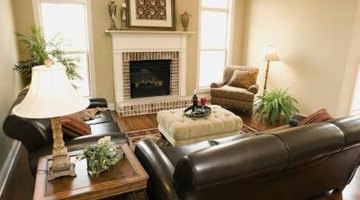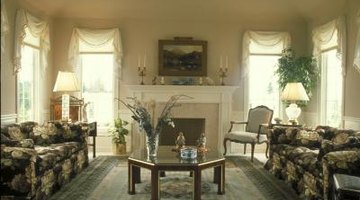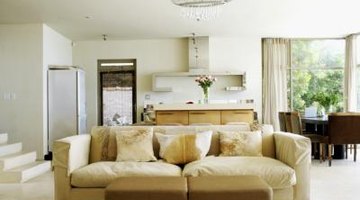Proper placement of large furniture pieces, such as a sofa, creates comfortable flow through any home. No matter whether you live in a cosy downtown apartment or a grand seaside mansion, a poorly placed couch stands out like a sore thumb. There are a few decorating rules to mull over when placing a couch, such as scale, foot traffic, the area rug and layout. Positioned right, a sofa defines a room and helps create a harmonious home.
Scale

You might think that a large sofa or a sectional should automatically go against a wall to allow for additional space in the room, but that is not always the case. A room used for entertaining focuses on a cosy seating arrangement, so bring the seating in to the middle for intimacy. No matter what the room's purpose, if you have a bulky sofa you will need to create balance so that the space will not look as if it is about to topple over. A hefty bookcase, a pair of overstuffed chairs, grand fireplace, or even a big screen TV across from a chunky couch gives the necessary visual "weight" to even out a room. If you will be placing a large sofa against the wall, keep in mind that it should not take up more than 3/4 of the wall's length. A small room typically works better with a small-scale sofa, and remember to never block doorways or windows.
- You might think that a large sofa or a sectional should automatically go against a wall to allow for additional space in the room, but that is not always the case.
Foot Traffic

Normally, you should provide comfortable flow around a seating arrangement rather than through it. For example, if your home's main entrance comes directly into your living room, create a passage way by placing the back of the couch as a half-wall, forming a foyer, or hall. This diversion lets the eye determine a natural route from the main door to other areas of the home. Place a small table near the door for keys, and a handy coat rack, if needed, to define the entrance space.
- Normally, you should provide comfortable flow around a seating arrangement rather than through it.
- For example, if your home's main entrance comes directly into your living room, create a passage way by placing the back of the couch as a half-wall, forming a foyer, or hall.
The Area Rug

A beautiful area rug is often the springboard for the design of a room. A rug should not swallow the room or appear like a tiny island lost in a vast sea. The basic rules of furniture placement regarding rugs are "all feet on" or "all feet off." The feet of a sofa, chairs and side tables should either skim the edges of the area rug or stand completely on it, bordering the decorative throw, whether against a wall or floating in the middle of a room. Choose the size of rug that works for a space depending on whether you want the foot traffic to pass around the furnishings or simply enter and settle in.
- A beautiful area rug is often the springboard for the design of a room.
- The feet of a sofa, chairs and side tables should either skim the edges of the area rug or stand completely on it, bordering the decorative throw, whether against a wall or floating in the middle of a room.
Layout

Many open-floor-plan homes have obvious dining and living room spaces laid out in one large area. There may be a chandelier hanging outside of the kitchen, determining the spot for a table, and a fireplace at the far end alluding to lounge seating. This is the ideal time to place a sofa somewhere in the middle of the room, as a visual divider. The back of a couch or the backs of a pair of chairs entice the eye to form a clear image of defined layout. Leave the equivalent width of a hallway, about 36 inches, between the visually divided rooms for comfortable passage. If you have generous square footage to work with, place a sofa table behind the couch as a side board on which to spread food and set a striking floral arrangement or sculpture.
- Many open-floor-plan homes have obvious dining and living room spaces laid out in one large area.
- There may be a chandelier hanging outside of the kitchen, determining the spot for a table, and a fireplace at the far end alluding to lounge seating.
